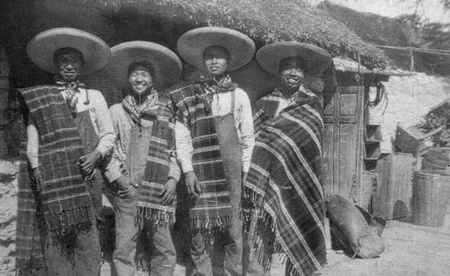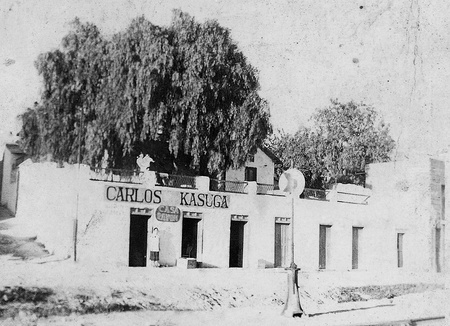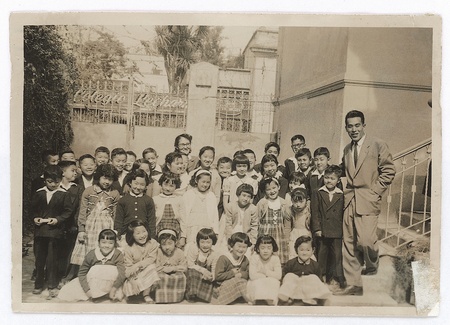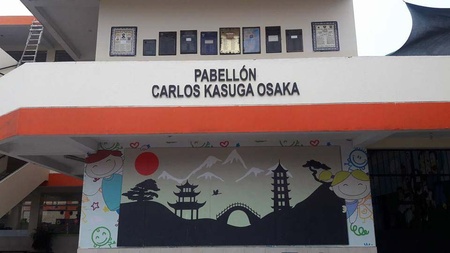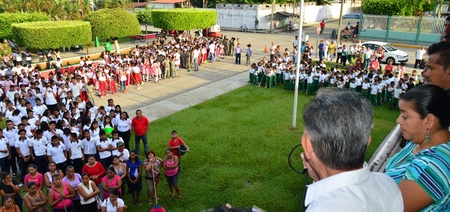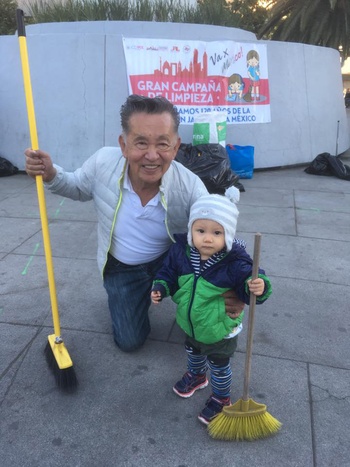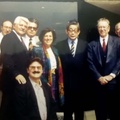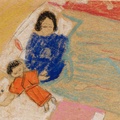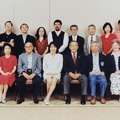In October 2017, leading Mexican businessman Carlos Kasuga Osaka celebrated his 80th birthday. Carlos is known to many as Chairman of the Board of Directors of Yakult, a Japanese company. He has also become very famous as a public speaker, with thousands of followers on social media.
Behind the success of Carlos Kasuga is a story of hard work and dedication, both personal and by the Japanese community. However, this story is not so well known. The son of Japanese immigrants from Nagano Prefecture, Carlos Tsuyoshi (剛), as his parents named him, was born in a small town in central Mexico in the state of San Luis Potosí.
His father, Tsutomu Kasuga, had come to Mexico in 1930 at the age of 20, from a town in Nagano Prefecture where most people earned their living from raising silkworms. When the global economic crisis of 1929 cut the value of their product in half, misery and unemployment affected many of Nagano’s peasant families. Faced with such a dire situation, many young people from the prefecture left Japan for countries in Latin America.
During his first years in Mexico, Tsutomu worked as a laborer on a ranch owned by another Japanese immigrant, who had brought him there under the yobiyose system, through which he obtained an entry visa with no problem. Tsutomu quickly realized there wasn’t much of a future for him at the ranch, so he didn’t stay there long. Instead, he moved to the town of Cerritos in San Luis Potosí to work with merchant Teikichi Iwadare, who owned a large store.
In 1936, once he was firmly established in Iwadare's store, Tsutomu asked his relatives in Japan to look for a young woman there who would be willing to move to Mexico and marry him. Through a letter (and a photograph) he sent to the young woman, Tsutomu explained that although he wasn't wealthy, he was an honest man who would work hard to support a family. The young woman, Mitsuko Osaka, accepted his proposal and moved to Mexico with just a few personal items and two treasures she couldn't leave behind: a Japanese flag and her book of poetry.
When she arrived in Cerritos, Mitsuko met her husband for the first time, and from that day forward the two worked worked intensely side by side to achieve their dream of building a better future for them and their first-born child, born in October 1937 in the same store where they worked.
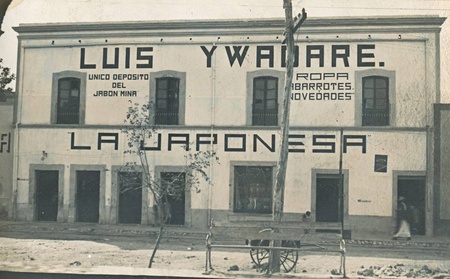
This important business offered a wide variety of merchandise and served not only the town of Cerritos but several other villages in the area as well. For Tsutomu and Mitsuko, this was an opportunity to study in a wonderful "university" where they learned not only to communicate in Spanish with customers, but how to manage the store. After a couple of years they were ready to "graduate" and open their own business with their savings and support from suppliers, who provided them with merchandise on credit. The Carlos Kasuga store opened in the town of Cárdenas in September 1938, and very quickly became a major goods distribution center, enabling the family to earn enough income to buy a house and a truck.
When little Tsuyoshi turned four years old, the war between the United States and Japan was on the verge of erupting. The conflict drastically affected the lives of thousands of immigrants living in many countries in Latin America. The Japanese attack on the Pearl Harbor naval base in December 1941 unleashed the persecution of immigrants and their children, who were considered "enemies" from that time forward, even though the majority of them were already citizens of the countries where they were born.
The U.S. government requested that Mexico immediately move all immigrants living near the border to the center of the country. The FBI and U.S. intelligence agencies with operations in Mexico maintained detailed census files on immigrants, with information about who they were and where they worked. In the months that followed, instructions were given to move all people of Japanese descent to Mexico City and Guadalajara.
In San Luis Potosí, the Kasuga family received the order in mid-1942. Although municipal authorities from Cárdenas reported to the federal government that the family was "honorable, hard-working and law-abiding" and that there was no need to move them, their request was denied. Carlos Kasuga recalls that one of the few times he saw his mother cry was when the people of Cárdenas accompanied them to the train station to say goodbye.
In Mexico City, the Kasugas and other families who arrived under the internment order lived near each other in the Tacubaya neighborhood. There, the community decided to prioritize the opening of a school for children, using what little resources they had for their education. The Tacubaya Gakuen school enabled Tsuyoshi and hundreds of children who were suddenly living in Mexico City to begin studying the Japanese language and other subjects. Tsuyoshi and his classmates had to study twice as hard since in addition to attending the community school, they also attended public school.
To support his family, and with the experience acquired in retail, Tsutomo Kasugo began to sell fruit and vegetables on the streets near Mexico City’s central market. Later, once the war had ended, the Kasuga and Yamazaki families opened a candy shop, which generated enough income to improve their economic situation. This was possible thanks to very hard work by the whole family, as the candy shop was open every day except New Year's Day. From an early age, in addition to studying, Tsuyoshi worked alongside his parents. Life itself began to show him that the road to a better future could only be paved with great effort, dedication and work.
A few years later, young Tsuyoshi earned a degree in accounting at the Banking and Business School. The education and training he received during those years was not only focused on acquiring knowledge, but also sustained by the values that Japanese immigrants brought from Japan: honesty, respect, generosity and a strong work ethic. Decades later, these values that have sustained him since childhood, and which are a heritage of the history of the immigrant community in Mexico, would enable Carlos to establish his own companies and achieve great success by transmitting those values to thousands of people through his speaking engagements.
In 1956, Carlos Tsuyoshi was one of the first dekasegui to study in Japan, without a scholarship, at Sophia University in Tokyo. During his stay in Japan, he learned that new kinds of plastic were being developed in Japan's toy industry. With this training, he and his family founded a small business that eventually became the leading maker of inflatable toys: Industrias Kay.
The business grew quickly due to the design of its products and the use of plastic imported from Japan, which was of better quality and durability than their competitors’. Demand for toys was so strong that the company opened two additional plants to fill orders from countries in Central and South America. In 1968, when the Olympic Games were held in Mexico, Kay was commissioned to make the huge Olympic rings that floated up to the sky in the opening ceremony.
In addition to his entrepreneurial activities, Carlos Kasuga has dedicated a great deal of energy to supporting education and organization of the Nikkei community in Latin America. In the town of Acacoyagua, Chiapas, where the first Japanese immigrants arrived in Mexico in 1897, he has given generously to the secondary school, as well as to Escuela José Gálvez in El Callao, Peru. Both establishments offer high-quality education to Nikkei and other residents of those economically disadvantaged areas.
Furthermore, Carlos Kasuga's goal is to promote education based on values such as cleanliness and to ensure that the lessons expand beyond the schools. The trash collection campaigns led by Carlos himself, in which hundreds of people participate, have helped inculcate these values in a collective way. His philosophy is that when a problem such as littering exists, the solutions can be found in the hands of the people themselves as well as the participation and collaboration of the community.
Other achievements that have benefited from Kasuga’s firm and enthusiastic support are the Panamerican Nikkei Convention (COPANI), with the motto "Being better citizens," and the founding of the Panamerican Nikkei Association in 1981 (Carlos was the first president). These collective efforts by Japanese descendants have strengthened Nikkei culture and history throughout the continent.
Tsuyoshi, now 80 years old, continues to work as hard as his name indicates, never allowing himself to be defeated by life's challenges. It is clear that his roots are planted deeply and firmly in the ground. The duty of Nikkei descendants, then, is to honor and raise awareness about the pioneers who arrived on this continent in the late 19th century and established their legacy, as Carlos Tsuyoshi Kasuga Osaka has done.
© 2017 Sergio Hernández Galindo



